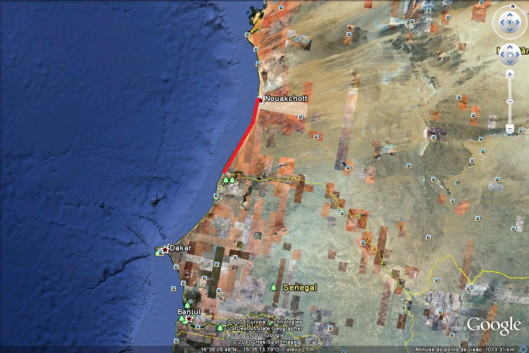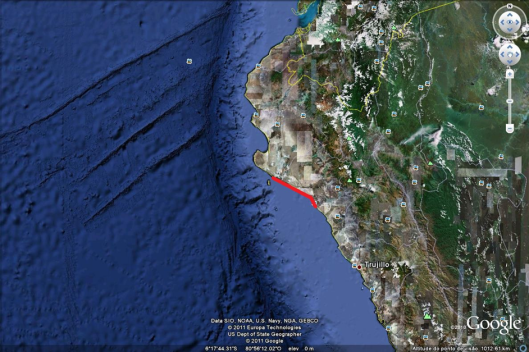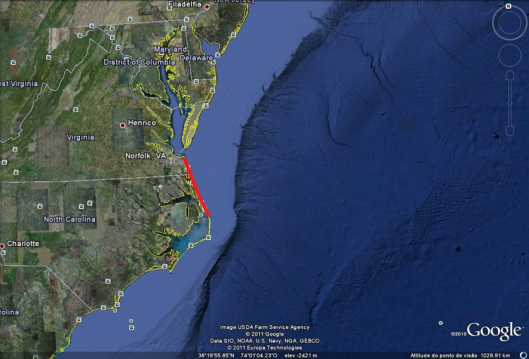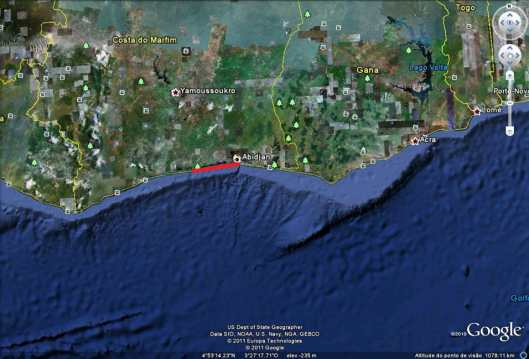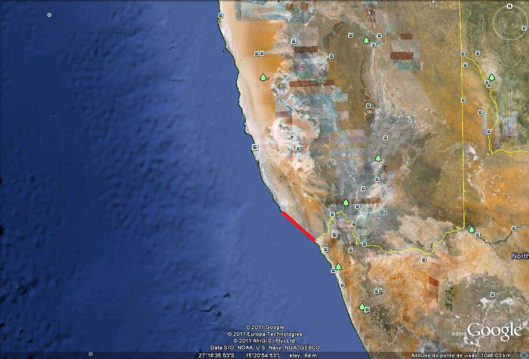DOMINGUES, Marcelo Vinicius de la Rocha. Geographer, PhD In Human Geography
Human and Information Sciences Institute, Federal University of Rio Grande – FURG
Rio Grande – Rio Grande do Sul – Brazil
In recent research on the internet motivated by the pursuit of the most extensive ocean beaches in the world, demanded by students of Geography FURG, the number of beaches that claim the title is surprising. This is a genuine dispute between places in different continents, captained by Eighty Mile and Cassino Beaches in Australia and Brazil respectively, which showed up on Google Earth as the real world’s largest ocean beaches. However, neither one nor the other is. This dispute led to further research in order to try to clarify possible misunderstandings on the subject, further, however, to give finality to the subject from the results achieved, the criteria presented below can obviously be challenged.
Criteria used for classification
1º) Continuous beach line – sandy and / or rocky beaches were identified by taking into account the absence of physical interruptions along the entire extension of the beach line from one end to the other of the same, that is, the beaches could not present physical obstacles (canals, spillways, dune fields, rocks, vegetation, small headlands) that prevented a 4×4 vehicle drive through them in their entirety by the so called foreshore and backshore interdital beach zone. The beach environment in all its physical length was therefore considered;
2º) No political-administrative division – the existing political-administrative divisions were disregarded both between municipalities in the same region and between regions within a country, or even regions between two contiguous countries, ie, the total physical extension of the beaches was considered, regardless of whether the same start and finish in one municipality and end in another, start in one region and finish in another, or even start in a country and finish in another. For example, Hermenegildo with 153 km in the municipality of Santa Vitória do Palmar and Cassino with 67 km in the city of Rio Grande in Brazil form a continuous ocean beach (Restinga of Rio Grande) with 220 km flight length and 242 km long on a 4×4 undercarriage vehicle. Whereas Cotonou/Lagos was the only ocean beach identified here that stretches by the shores of two countries, starting in Benin and ending in Nigeria or vice versa;
3º) Minimum extension of at least 100 km – only the ocean beaches extending at least 100 km of continuous overflight beach line were considered. This criterion eventually excluded Chennai in India and Cox’s Bazar in Bangladesh from the list, as well as Long Island in New York and the east coast of Florida, both in the United States, which, despite having more than 100 km long, are sectioned by different channels, without showing continuous stretches of beach equal to or above 100 km. Likewise, for example, part of the eastern coast of the island of Madagascar in Africa and Papua New Guinea in Oceania were excluded, whose beach lines extend for hundreds of kilometers, but are cut by numerous rivers and/or lake mouths, none of which have minimum extensions of 100 km in overflight line. The same applies to the coastline that shapes the Gulf of Carpentaria in Australia, which is also sectioned by numerous rivers and/or lake mouths, none of which have minimum extensions of 100 km. Based on this criterion, at least two dozen ocean beaches were excluded from the analysis, these mostly in the United States and Mexico, as well as India, Malaysia, New Zealand, Egypt, Thailand, Indonesia, Yemen, Vietnam, Eritrea and Central America;
4º) Overflight line measurement – extensions of the beaches were measured initially in overflight line of the coastal from Google Earth in order to identify the longer ocean beaches, avoiding in this way at first, distortions generated between a straight coast line of more sinuous one. The overflight lines considered here do not refer to the shortest path in a straight line between the two endpoints of an ocean beach, which would also generate a lot of distortion to less given the differences in beach environments identified here (sometimes more straight, more concave or sometimes more convex), as discussed in the following images, but the route by plane as true as possible about the different beach lines between its extreme points;
5º) Terrestrial measurement by a 4×4 vehicle – on second plan, the existing distortions between the beaches more straight and more sinuous (concave or convex) was considered, since there are obviously differences between the ability of an aircraft to follow the sinuosity of the shoreline and that of a 4×4 vehicle to do so. Thus, values were added to the initially obtained full overflight extension line, between 10% and 20% (more rectilinear beaches), 30% (Cadaley/Dhimbii in Somali Republic, San Carlos/Cuzi in Venezuela) and 50% (extreme cases Swakopmund/Terrace Bay in Namibia, Eucla-Nullarbor in Australia, Shaqra/Al Hawrah in Yemen, St. Francis Bay/Sandwich Bay in Namibia, Xai-Xai/Ingale in Mozambique and Khoor-Shoora/Xiis in Somali Republic, which have significant sinuosity in their beach lines) in order to show clearly the difference which is obtained when performing measurements in both modes;
6º) Use of the beaches – the existence of cities and/or balnearies and/or fishing villages structured along the lines of beach were disregarded, that is, whether or not there uses was more or less intense of the same was dismissed. Thus, the beaches with extensions greater than 200 km are presented as true “human deserts,” with few urban centers (cities and/or balnearies and/or fishing villages) structured along the beach lines. This does not mean the absence of relatively large urban areas and also important recreational uses (housing, tourism and summer) of the same. Whereas the ocean beaches identified here with extensions between 100 km and 200 km are mostly presented, as politically fragmented in several cities and/or beaches. Padre Island, Texas, United States, is by far the most urbanized of beaches identified herein. As for the ten largest ocean beaches in the world, except the second, fifth, sixth, eighth and tenth, which have cities and/or beaches structured in their extremes, are true human deserts maintaining their beach environments almost intact. Here, the major human deserts are Cadaley/Dhimbii in Somali Republic, Eucla-Nullarbor in Australia and St. Francis Bay/Sandwich Bay in Namibia, perhaps the most beautiful beaches of the wild identified herein.
Based on these criteria thirty-one (31) ocean beaches that have minimum length of 100 km to a maximum of 700 km in overflight line (aircraft flying over the entire length of each of the thirty-one beach lines identified, from one extreme to the other, but not in a straight line), were identified on four continents together with their respective extensions by a 4×4 vehicle, for obvious reasons, presented by the 5th criterion, extends, in some cases significantly, the extensions of these beaches.
It is noteworthy that, due to the differences between the beaches, for some there is an overlap between the extreme points (identified localities – cities and/or beaches and/or fishing villages, or physical accidents such as bays, rivers and/or estuaries – as extreme points on each beach) and the beginning and the end thereof, a feature common to most beaches identified herein. For others, however, the identified extreme points do not coincide with the beginning and end thereof, as is the case for longest beach in the world located in Somali Republic, where the beach extends for approximately 80 km to the north beyond Dhimbii and about 20 km beyond Cadaley towards the south. The same for the second largest beach in the world in Namibia, where the beach stretches for about 70 km beyond Terrace Bay in the north; the world’s fourth largest beach in Mozambique, where the beach stretches for about 25 km south of Xai-Xai; and the fifth largest beach in the world also in Somali Republic, where it extends about 20 km beyond Baraawe in the north.
As the analysis was performed from the images generated by Google Earth (with images with different dates and distortions inherent in this type of analysis), it is obvious that a field survey conducted in each of these beaches will surely find a few different numbers to those presented here, whether by the overflight extensions, or extensions on a 4×4 vehicle. That is, the values present in the following table have been rounded in order to facilitate the analysis, especially for the values of the extensions proposed by the 4×4 vehicle for some beaches whose coastlines are quite sinuous, as in the case of Swakopmund/Terrace Bay in Namibia, Eucla-Nullarbor in Australia, Shaqra/Al Hawrah in Yemen, Xai-Xai/Ingale in Mozambique, St. Francis Bay/Sandwich Bay in Namibia, Khoor-Shoora/Xiis in Somali Republic and San Carlos/Cuzi in Venezuela.
This task of precise measurement of these stretches of the beach should be research work to be undertaken or by Research Institutes/Universities where there are sectors oriented to such environments, or by the National Geographic or the Discovery, in order to confirm the data presented and withdraw, add to or amend the list of beaches here presented. Here is the challenge to such institutions, since they produce rich educational/scientific material about these ecosystems on Earth at least fascinating, besides contributing to a possible development of tourism for these locations/regions, especially for countries with low socio-economic dynamics, as is the case, for example, of Somali Republic, steeped for years in a civil war. It is hoped that this paper can actually bring some benefit to them.
Since the lone research undertaken here lasted only four months, it is likely that some beaches with stretches over 100 km in overflight line have not been identified, given the enormity of the coasts of all continents. In this case, it is expected that those who know a beach that fits the above criteria do the correct indication of the same.
Australia stands out as the country with the largest number of beaches with over 100 km long in overflight line, having five of the thirty-one largest ocean beaches in the world, based on the criteria used here. Africa stands out as the continent with the largest number of beaches with over 100 km long in overflight line, having sixteen (50%) of thirty-one largest ocean beaches in the world identified herein.
From the above criteria, we constructed a table which sets the thirty-one largest ocean beaches in the world grouped as follows: beaches with stretches of 200 km to 700 km in overflight line; beaches with stretches of 150 km to 190 km overflight line, and beaches with stretches of 100 km to 140 km in overflight line. Each group of beaches is accompanied by their locational images of each of these beaches, obtained from Google Earth at an average altitude of 1,050 km, allowing a visual comparison of all the beaches in the table.
It should also be noted in this table, that the thirty-one largest ocean beaches in the world are located in a strip that extends from 40° north latitude (fourteen beaches) and 45° south latitude (seventeen beaches). However, a curious uniformity in the geographical distribution of these beaches was found between the two hemispheres. A curious fact, if one considers that the northern hemisphere has ¾ of land and ¼ water, and the southern hemisphere the opposite, ¼ land and ¾ water. Thus, following the distribution proposed above, the first group of beaches, where are the ten largest ocean beaches in the world, four are located in the northern hemisphere and six in the southern hemisphere. In the second group of beaches, five are located in the southern hemisphere and three in the northern hemisphere. In the third group of beaches, seven are located in the northern hemisphere and six in the southern hemisphere.
|
Rank |
Region |
Country |
Beach |
Extension (overflight line) |
Extension (4×4 vehicle on the beach) |
|
1º |
AF |
Somali Republic |
Cadaley/Dhimbii |
700 km |
910 Km |
|
2º |
AF |
Namibia |
Swakopmund/Terrace Bay |
420 km |
630 km |
|
3º |
OC |
Australia |
Eucla-Nullarbor |
280 km |
420 km |
|
4º |
AF |
Mozambique |
Xai-Xai/Ingale |
270 km |
405 km |
|
5º |
AF |
Somali Republic |
Kismayo/Baraawe |
245 km |
294 km |
|
6º |
AF |
Mauritania |
Nouakchott/Saint Louis Estuary |
235 km |
282 km |
|
7º |
OC |
Australia |
Eighty Mile Beach |
235 km |
260 Km |
|
8º |
ME |
Yemen |
Shaqra/Al Hawrah |
230 km |
345 km |
|
9º |
AF |
Namibia |
St. Francis Bay/Sandwich Bay |
220 km |
330 km |
|
10º |
SA |
Brazil |
Hermenegildo/Cassino |
220 km |
242 km |
|
11º |
SA |
Argentina |
Mar Chiquita/San Clemente del Tuyú |
190 km |
228 km |
|
12º |
OC |
Australia |
Murray River Mouth/Kingston Se |
180 km |
216 km |
|
13º |
SA |
Brazil |
Tavares/Tramandaí* |
175 km |
193 km |
|
14º |
AF |
Libya |
Misratah/Sirte |
170 km |
221 km |
|
15º |
AF |
South Africa |
Saint Lúcia Bay/Kozi Bay |
170 km |
213 km |
|
16º |
SA |
Peru |
Puerto Eten/La Trampa |
170 km |
204 km |
|
17º |
AF |
Senegal |
Dakar/Gabar |
160 km |
176 km |
|
18º |
AF |
Somali Republic |
Khoor-Shoora/Xiis |
150 km |
225 km |
|
19º |
SA |
Venezuela |
San Carlos/Cuzi |
140 km |
182 km |
|
20º |
NA |
United States |
Virgínia Beach/Nags Head |
140 km |
154 km |
|
21º |
OC |
Australia |
Woodside Beach/Lakes Entrance |
135 km |
162 km |
|
22º |
AF |
Sierra Leone |
Kakhei/Mina |
125 km |
156 km |
|
23º |
AF |
Namibia |
Angra Fria/Kunene River Mouth |
125 km |
150 km |
|
24º |
AF |
Nigeria |
Lagos/Olokata |
125 km |
144 km |
|
25º |
NA |
United States |
Padre Island** |
120 km |
144 km |
|
26º |
AF |
Côte d´Ivoire |
Abidjan/Braffédon |
115 km |
125 km |
|
27º |
SA |
Peru |
Máncora/El Álamo |
110 km |
138 km |
|
28º |
AF |
Benin/Nigeria |
Cotonou/Lagos |
110 km |
126 km |
|
29º |
AF |
Namibia |
Orange River Mouth |
105 km |
131 km |
|
30º |
OC |
Australia |
Nuytsland |
105 km |
126 km |
|
31º |
SA |
Argentina |
Pehuén-co/Balneário Oriente |
100 Km |
110 km |
AF = Africa, OC = Oceania, SA = South América, NA = North América, ME = Middle East.
* If the Brazilian Institute of Environment and Natural Resources (IBAMA) can prevent the artificial opening of the bar of the Lagoa do Peixe, it will close quickly and will enable the emergence of a continuous beach extending through 260 km of overflight line and of at least 290 km to 300 km by land, could become the fifth largest ocean in the world beach extension.
** Only the longest stretch of continuous beach front was considered, as a whole, Padre Island has about 210 km overflight line, however, it is non-continuous, with inlets of channels that cross the beach.
Locational images of each of these beaches are presented, obtained from Google Earth at an average altitude of 1,050 km, enabling a visual comparison of all thirty-one beaches present in the table.
Google Earth images (altitude of 1050 km, with corresponding visual proportionality in the size of beaches).





